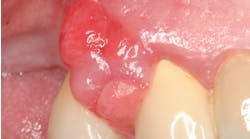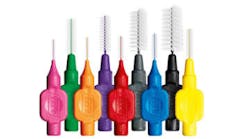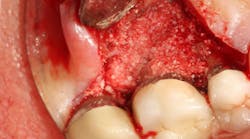In case you missed it: Three lecture summaries from the 2014 AAP Dental Hygiene Symposium
In late September, I had the opportunity to attend the 100th Annual American Academy of Periodontology Meeting in San Francisco. On the Saturday of this meeting, the California Society of Periodontists hosted a Dental Hygiene Symposium featuring three knowledgeable presenters whose lectures I will summarize below.
“The Perio-Systemic Connection: Where Are We Today?” Dr. Brian L. Mealey —
Dr. Mealey’s lecture provided an overview of the links between inflammatory periodontal infections and common systemic conditions such as diabetes, cardiovascular disease, and adverse pregnancy outcomes. He presented research indicating that poor glycemic control in diabetic patients increased their risk for periodontitis, and that diabetic patients with periodontitis were at greater risk for having poor blood sugar control. (1) Dr. Mealey examined systematic reviews of intervention trials demonstrating that periodontal treatment is often associated with an improvement in glycemic control. (2,3)
Dr. Mealey used a histological slide to depict the incredibly thin layer of sulcular epithelium that exists as the only barrier between the oral cavity and the rest of the body. The link between periodontal disease and cardiovascular disease was confirmed by evidence indicating patients induced endotoxins into their bloodstreams simply by chewing gum. Patients with periodontitis were more susceptible to endotoxemia. (4) Periodontal infection may increase fibrinogen and C-reactive protein, which are risk factors for myocardial infarction and stroke.
The adverse pregnancy outcomes that Dr. Mealey focused on were low birth weight and preterm birth. In the systematic review (5) that Dr. Mealey cited, a significant number of studies showed association between maternal periodontal disease and increased risk of preterm birth/low birth weight. Throughout his entire lecture, Dr. Mealey was careful never to use the word “cause” when relating periodontal disease to any of the conditions listed above, as association does not prove causation.
ALSO BY COLLEEN OLSON |You graduated from dental hygiene school! Now what?
ALSO BY COLLEEN OLSON |Strategies to help the teenage patient achieve greater success with oral hygiene
“Periodontal Microsurgery and Endoscopy: Seeing Is Believing!” Dr. John Y. Kwan —
Dr. Kwan gave us a good look at the most recent technological advances in surgical microscopes and periodontal endoscopes, which are being used for minimally invasive periodontal therapy. A periodontal endoscope is a small, fiber-optic system that provides an image of the subgingival root at 20 to 40 times magnification. The real-time video that the cable captures is displayed on a screen in front of the clinician. The fiber-optic cable is mounted on a special probe system that allows the clinician to use the probe and scaling instruments at the same time. Dr. Kwan demonstrated with video the ability of microscopes to aid in surgery and endoscopes to aid in scaling and root planing. The periodontal endoscope uses a shield to hold back the gingival tissue and a stream of water to clear the viewing field. The periodontal endoscope is a good tool to use with patients for whom surgery is contraindicated or for patients who are resistant to surgery.
“Dental Implants & Maintenance for the Dental Hygienist” Dr. Erik F. Sahl —
After a brief review of basic implant structure, Dr. Sahl discussed the types and causes of peri-implant disease. He thoroughly discussed what we, as dental hygienists, should be doing when it comes to treating patients with implants. Dr. Sahl recommended taking vertical bitewing X-rays that give a clear view of bone levels, probing the implant sulcus, and noting any bleeding on probing, suppuration, or inflammation around the implant. Special attention should be paid to implant patients who exhibit any of the following risk factors: smoking, diabetes, history of periodontal disease, poor oral hygiene, residual cement, and occlusal overload. Dr. Sahl recommended probing the implant with a standard probe, as plastic probes tend to be wider and less accurate. He also noted that there is no “normal” probe depth for implants and that all other indicators of disease should be taken into consideration. Bone loss and bleeding on probing are particularly important indicators of peri-implant disease. The lecture was concluded by a review of hygiene aids that could be used around implants, including proxy brushes, plastic interdental picks, and tufted floss. Wow, there are a lot of implant cleaning aids for patients that I wasn’t aware of!
I thoroughly enjoyed all three presentations and would recommend any of the above speakers. Continuing education events such as this Dental Hygiene Symposium help to keep the dental community up-to-date with the latest research and technology. I encourage the entire dental community to place a strong focus on continuing education.
References
1. Taylor GW, Burt BA, Becker MP, et al. Severe periodontitis and risk for poor glycemic control in patients with noninsulin-dependent diabetes mellitus. J Periodontol 1996;67:1085-1093.
2. Sgolastra F, Severino M, Pietropaoli D, Gatto R, Monaco A. Effectiveness of periodontal treatment to improve metabolic control in patients with chronic periodontitis and type 2 diabetes: a meta-analysis of randomized clinical trials. J Periodontol 2013;84:958-973.
3. Engebretson S, Kocher T. Evidence that periodontal treatment improves diabetes outcomes: a systematic review and meta-analysis. J Periodontol 2013;84(4 suppl):S153-S163.
4. Geerts SO, Nys M, De MP, Charpentier J, Albert A, Legrand V, Rompen EH. Systemic release of endotoxins induced by gentle mastication: association with periodontitis severity. J Periodontol 2002;73:73-78.
5. Chambrone L, Guglielmetti MA, Pannuti CM, Chambrone LA. Evidence grade associating periodontitis to preterm birth and/or low birth weight: I. A systematic review of prospective cohort studies. J Clin Periodontol 2011;38:795-808.








